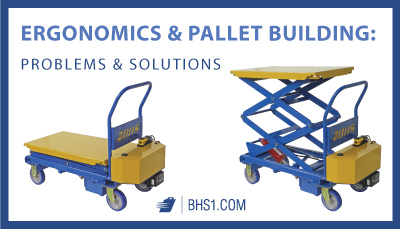We use cookies to make your experience better. To comply with the new e-Privacy directive, we need to ask for your consent to set the cookies. Learn more.
Ergonomics and Pallet Building: Problems and Solutions
Rising worker's compensation claims and an aging workforce responsible for pallet building tasks are causing warehouse managers to rethink their processes. Add in the fact that industry experts project the use of pallets to increase through 2019, and you can see why it's necessary to reevaluate the pallet building and unloading process.
Even if warehouse managers didn't care about productivity and preventing injuries to their staff, which is an unlikely proposition, insurance companies are insisting that clients implement ergonomic solutions in warehouses to reduce payouts for injured staff.
Worker's Comp Cases Strain Insurers' Pocketbooks
The issue is complex, but it boils down to this: Material handlers are older and in worse shape than they have been in the past, and the strains of building and unloading pallets are taking a larger toll.
The situation is untenable for insurers and warehouse managers alike. Thankfully, there's a solution. 
Many operations already take advantage of ergonomic equipment, but some remain hesitant to invest in tools designed specifically for a single task. Insurance companies might finally convince these holdouts that there is no other option.
Investment in Ergonomics Increases Productivity
If warehouse managers need another reason to invest in ergonomic equipment, there's a glaringly obvious one. Implementing ergonomic equipment not only reduces worker injuries (which helps satisfy the insurers, and workers alike), it also increases productivity. When work is easier, productivity rises.
Jim Gallante, chairman of the Ergonomic Assist Systems & Equipment (EASE) Council explained the situation to industry publication Modern Materials Handling.
“If you have an ergonomic issue in your process, it can be directly associated to a production inefficiency," Gallante said. "And for many, enhanced productivity often helps to justify the investment in more ergonomically designed equipment.”
Targeting Stressful Spots in the Process
The essence of ergonomics lies in tailoring jobs to fit the person rather than making the person adjust to the job. This can be done through the use of lift tables, tilt tables, or any other mechanical equipment that reduces stress on workers' musculoskeletal systems. Here are some ways to reduce back strain during pallet loading and unloading:
-
Use a lift table to vertically position loads within a comfortable zone. Mobile lift tables can be easily transported to various packing or unloading sites in a warehouse.
-
Invest in a turntable top to reduce reaching. Reaching can stress the back even more than bending and lifting. Rotating tabletops allow employees to reposition the pallet so that they're only packing the area directly in front of them.
-
Utilize tilt tables to reduce shoulder strain by tilting loads to optimal angles.
-
Provide staff with a pallet carousel, which combines the ergonomics of a lift table with an easy-to-rotate tabletop.
The ideal ergonomic table would self-position loads, spin 360 degrees, and have a small enough base that workers can stand close to the pallet. Whether you want to keep your insurance company happy, increase productivity, or protect your workers, the solution is the same — invest in ergonomic tables that make pallet building and unloading easier.
References:
"Industry Study 3314 - Pallets." FreedoniaGroup. The Freedonia Group, Aug. 2015. Web. 22 June 2017.
"Materials Handling and Storage." OSHA. Occupational Safety and Health Administration, United States Department of Labor, 2002. Web. 22 June 2017.
"The Mighty Pallet: A Supply Chain Powerhouse." InboundLogistics. Thomas Publishing Company, 4 May 2017. Web. 22 June 2017.
Specter, Sara. "Materials Handling Ergonomics: Minimize the Strain." MMH. Peerless Media LLC, 7 June 2017. Web. 22 June 2017.
